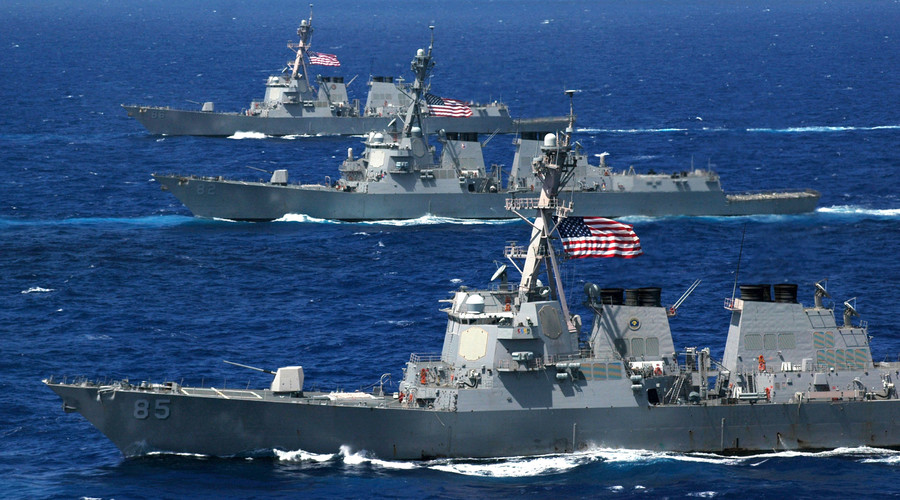
There is a disconnect between the resources that the U.S. Navy and its commanders in the Pacific say they need, and the budgets submitted by the Trump administration or proposed by the U.S. Congress. With little prospect that the Navy will grow at the rates its leaders say are required to stem an eroding advantage over great power competitors like China, the U.S. Pacific Command, which uses the largest share of the forces the U.S. Navy provides, is moving aggressively to build alternative capabilities to establish sea control without relying on additional ships or submarines.
The United States has 276 ships in its battle fleet today and ships currently under construction or under contract will bring the total in 2021 to 308 ships—the U.S. Navy’s previous shipbuilding goal. However, during his campaign, President Trump promised to build a 350-ship fleet, and shortly after his election the U.S. Navy revealed new analysis saying that it needed at least a 355-ship fleet to meet its mission requirements.
A 355-ship fleet would be a more than 15 percent increase the U.S. Navy’s shipbuilding goal, and while the Congressional Budget Office published a notional plan for how to achieve that size fleet by the 2040s, the Chief of Naval Operations, Admiral John Richardson, has said in a new white paper that the U.S. Navy needs that larger fleet in less than a decade, not in thirty years.
In the report, Future Navy, Admiral Richardson makes the case that the Navy’s global responsibilities and growing challenges from great powers like China present the U.S. Navy with an “exponential competition” that the United States must match to retain its advantage to either deter or win a potential clash:
…we must rapidly increase the number and capability of platforms: we must get to a higher build rate from which we continue to work our way forward… Most importantly, the future fleet must be on station ASAP! We need this more powerful fleet in the 2020s, not the 2040s.
But while Admiral Richardson closes with the admonition that “time is of the essence,” the Trump administration’s 2018 budget doesn’t move the needle much towards the goal of that bigger, more capable fleet, and certainly not in the short timeline the U.S. Navy wants. The President’s budget submission did not request any additional ships over the Obama administration’s plans, keeping the fleet on track to 308 ships. At literally the last minute, the Trump administration added a single additional ship – bringing the overall 2018 budget request to nine hulls – but without a plan for where the additional funds needed to build even this single additional ship would come from.
Nonetheless, while the President proposes budgets, it is the U.S. Congress that actually sets spending levels, and sea power advocates within the Congress have signaled that they want to accelerate the Navy’s shipbuilding plans. However, even those legislative proposals fail to substantially increase the U.S. Navy’s build rate. The Armed Services Committee of the House of Representatives, which authorizes defense spending, has proposed adding five more ships to the Navy’s budget, but pays for them using the Overseas Contingency Fund, an account originally intended to support War on Terror operations, instead of the normal shipbuilding account. Meanwhile, the Appropriations Committee, the House committee that actually allocates funding, is only proposing three additional ships. Neither proposal is likely to be enough to meet the needs of the fleet’s biggest customer, the U.S. Pacific Command.
The current head of the U.S. Pacific Command, Admiral Harry Harris, repeatedly tells Congress that he needs more resources to meet China’s growing capabilities and “assertive pattern of behavior.” Admiral Harris has called the U.S. Navy’s submarine fleet the United States’ “principal asymmetric advantage over China” but recently testified that Pacific Command only gets 50 percent of the submarines he estimates he needs. Despite this, neither the administration’s request nor either House committee responsible for the defense budget process have proposed adding additional submarines to the 2018 budget. Without a dramatic increase in submarine procurement, projected retirements under the current shipbuilding plan will leave the U.S. fleet with ten fewer attack submarines, down to 42, by 2030.
To mitigate the prospect of fewer Navy resources to balance the growing parity of China’s expanding fleet, Admiral Harris has had to investigate new ways to project sea control in his area of responsibility. At next year’s biennial Rim of the Pacific exercise, the world’s largest multi-national naval exercise, the U.S. Army will use a Norwegian-designed coastal defense cruise missile to sink a target ship. By giving the U.S. Army a mobile, ground-based anti-ship capability that it could deploy to the small islands and archipelagos along the first island chain that rings much of China’s coastline, the United States could conceivably project control over large swaths of ocean and strategic chokepoints that would otherwise require many more ships and submarines that do not appear forthcoming.



